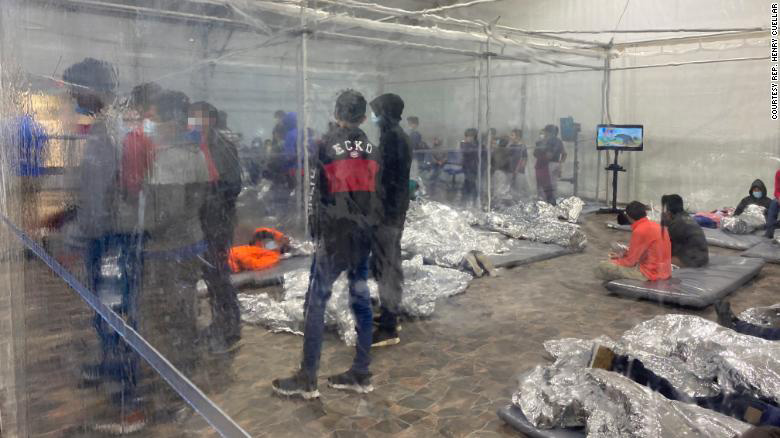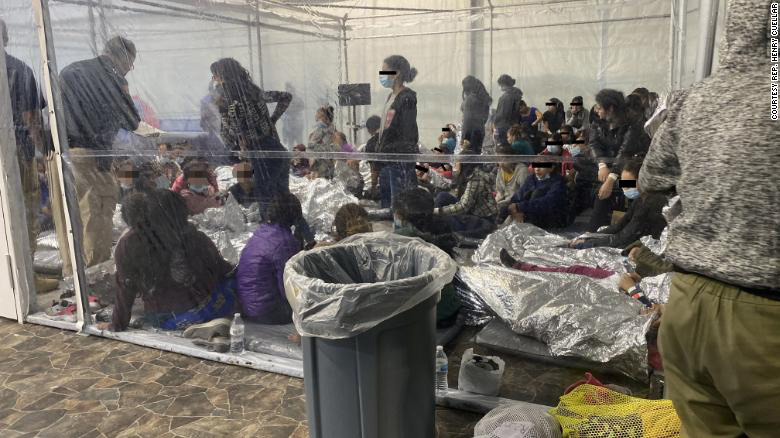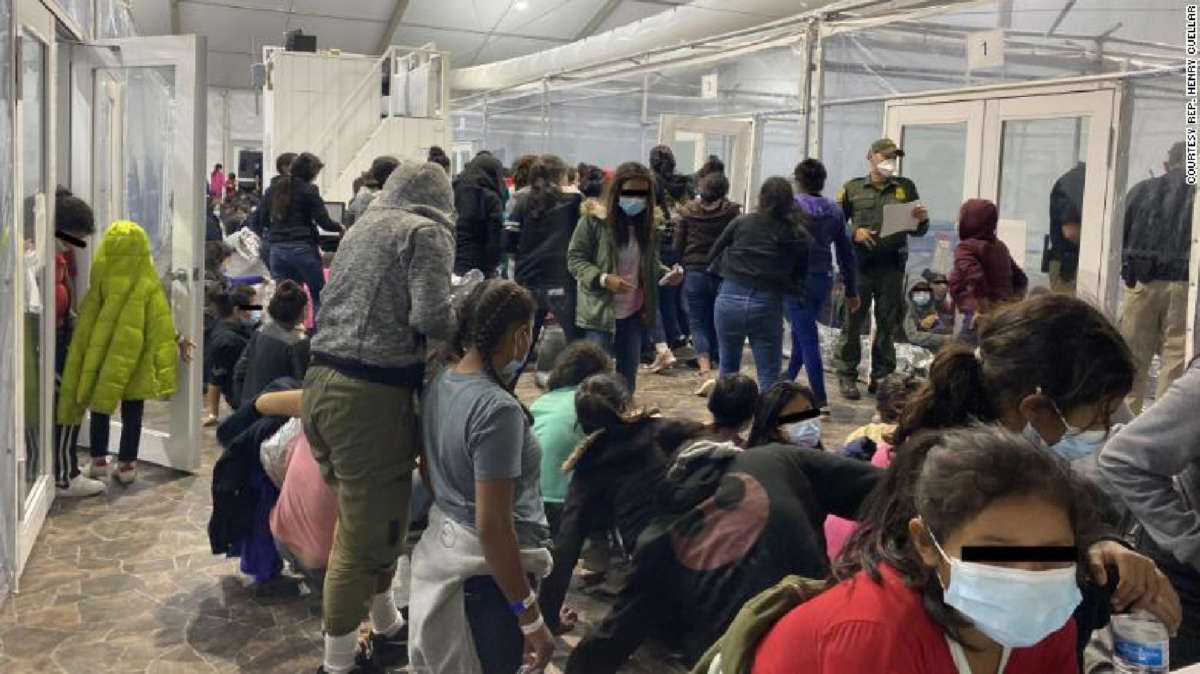Part of the Series
Despair and Disparity: The Uneven Burdens of COVID-19
Support justice-driven, accurate and transparent news — make a quick donation to Truthout today!
As corporate media and Republicans paint the influx of unaccompanied children on the U.S.-Mexico border as a “crisis” and “surge,” advocates and attorneys tell Truthout that legal and logistical complexities are being lost in these distorted portrayals.
The Biden administration, they say, faces the challenges of inheriting an asylum system that former President Donald Trump systematically dismantled, in addition to challenges posed by the ongoing global pandemic.
The increase in crossings is happening in part because 70,000 asylum seekers were already in line, stuck in Mexico after being forced to wait there under Trump’s restrictive Migrant Protection Protocols, according to advocates. The situation is not quite a “surge,” they point out, but a regular seasonal influx of asylum-seeking children bolstered by a backlog of demand because of last year’s COVID-19 border shutdown.
U.S. Customs and Border Protection has documented a “28 percent increase in migrants apprehended from January to February 2021, from 78,442 to 100,441.” But CBP’s own numbers show that undocumented immigration tends to spike in the spring. While last year’s number were down, due to the pandemic, fiscal year 2019 saw total apprehensions increase 31 percent during the same timeframe — a bigger rise than we saw this February.
That doesn’t mean the numbers aren’t high. While the increase in apprehensions began during the final months of the Trump administration, the numbers are on track to reach a level not seen in 20 years, Department of Homeland Security Secretary Alejandro Mayorkas acknowledged last week.
Moreover, the Biden administration needs to be moving faster, immigrant rights advocates say, to make critical changes to the asylum system that would allow the administration to release more kids held in CBP, Department of Health and Human Services (HHS), and Federal Emergency Management Agency (FEMA) camps and facilities in Donna, Carrizo Springs, Dallas and other sites throughout Texas.
Such changes, they say, are also necessary to alleviate a public relations disaster as the Biden administration scrambles to find bed space for the rising number of children crossing the border and blocks press from accessing CBP camps. A number of media outlets have published photos released by Texas Democratic Rep. Henry Cuellar revealing crowded conditions for immigrant and refugee children at the camps.

During a press conference Thursday, President Joe Biden said officials are working to open more facilities for children currently being processed, and move them more swiftly into homes. He also said he would grant media access to the facilities but declined to give an exact date.
“Really, what’s happening is we’re getting back online from a system that was completely trashed by Trump,” says Austin-based immigration attorney Kate Lincoln-Goldfinch. “We don’t have a ‘surge’ on the border, what we have is a legal system that is getting online after it got completely blocked.”
“Really, what’s happening is we’re getting back online from a system that was completely trashed by Trump. We don’t have a ‘surge’ on the border, what we have is a legal system that is getting online.”
Lincoln-Goldfinch tells Truthout she’s currently handling a case of a 14-year-old boy who has been held in CBP custody for days longer than the legally mandated 72-hour limit, even though his father is able to receive him. The boy has yet to be transferred to HHS’s Office of Refugee Resettlement, which is tasked with providing care for unaccompanied children entering the U.S. Lincoln-Goldfinch says CBP can’t tell her or the boy’s father where he is.
It’s just one case that reveals the administration’s broader struggle to transfer children from an agency staffed with Border Patrol officers to an agency staffed with social workers whose job is to care for children.
A recent Senate delegation to the border seems to confirm what Lincoln-Goldfinch is seeing, as members of the delegation reportedly witnessed overcrowded CBP camps during a recent trip to the border, while reporting that an HHS facility that could shelter up to 500 children housed just 78 kids at the time of their visit, according to The Washington Post.
The pandemic, however, complicates the picture when it comes to HHS’s shelter capacity, drastically reducing it due to the need for COVID-19 physical distancing guidelines and mandates. Still, the HHS facility Senate delegation members visited recently was far from housing even half its capacity.
“I think they’re just sort of hot potato-ing the problem by saying, ‘Well we’ll move the kids from this tent in Donna, to this random convention center in Dallas while we figure out what to do with them.’ It’s very much a short-term solution,” says Manoj Govindaiah, director of policy and government affairs at the San Antonio-based Refugee and Immigrant Center for Education and Legal Services (RAICES).
“I think they’re just sort of hot potato-ing the problem.”
Migrant justice activists, however, also point out that HHS youth shelters are increasingly mirroring detention centers. The Office of Refugee Resettlement contracts all migrant youth detention facilities and requires operators to collaborate with U.S. Immigration and Customs Enforcement and CBP.
Nonetheless, advocates say the administration needs to speed up the transfers of kids from CBP into HHS custody. Additionally, they say, it’s imperative that the Biden administration either tweak the legal definition of “unaccompanied” to include some extended family members, or co-locate HHS staffers at CBP sites to allow kids to be released with extended family members.
“What’s disturbing to me about what the Biden administration is doing, is that they’re treating family groups — where there may not be a biological parent in the group, but let’s say, it’s an aunt and a niece — they are taking those kids in as ‘unaccompanied’ minors,” Lincoln-Goldfinch tells Truthout. “That is something that needs to shift quickly under Biden.”
This is why it’s so critical that HHS and CBP increasingly adopt a co-location model that would reduce time children’s time in custody because HHS staffers, not CBP officers, can make more immediate determinations about who is an appropriate caregiver or sponsor to release children with or to, says Leah Chavla, a senior policy adviser at the Women’s Refugee Commission.

Biden said Thursday that his administration is working expand facilities to accommodate unaccompanied minors, telling reporters, “We’re providing for the space, again, to be able to get these kids out of the Border Patrol facilities,” and pointing to 5,000 new beds at Fort Bliss in west Texas.
In more than 80 percent of cases, CBP says, kids already have a relative in the U.S., and 40 percent already have a parent or legal guardian here. But while there is a complex “reality” to the need to process these children safely into home environments, Lincoln-Goldfinch says, “The Biden administration needs to be held accountable that they are doing this processing as quickly as possible and in the meantime are housing these kids, not detaining these kids, in a humane and comfortable environments.”
Biden Doubles Down on Title 42
Advocates and attorneys also argue the Biden administration needs completely scrap its remaining use of Title 42 of the public health code, which allows officials to use the pandemic as a reason to refuse asylum seekers entry. The American Civil Liberties Union filed lawsuits seeking to halt the Trump administration’s practice of using the code as a pretext to expel migrants.
“I don’t think it’s outside the realm of possibility that a family attempts to enter and is expelled under Title 42, and then the desperate parents are sending the kid by him or herself.”
As the case unfolds, Biden has partially lifted Title 42 as it applies to unaccompanied minors, but continues to invoke the code to expel thousands of Central American migrant families to Mexico as the Centers for Disease Control and Prevention reviews health conditions on the border. Mexico, however, isn’t always willing or able to receive them.
RAICES’s Govindaiah says the administration’s continued use of Title 42 is contributing to the uptick in border crossings. “I don’t think it’s outside the realm of possibility that a family attempts to enter and is expelled under Title 42, and then the desperate parents are sending the kid by him or herself and the kid is able to make it,” he says.
But the administration appears to be doubling down on its use of the public health code. President Biden told reporters Thursday that he’s negotiating with Mexican officials in hopes of getting the country to accept all migrant families expelled from the U.S. under Title 42.
Biden is also warning potential migrants not to come the border while officials devise alternative means for migrants to legally apply for entry that don’t require them to appear in person.
The administration is hardening its position as Republicans pushing even harsher immigration policies exploit the situation. Senators John Cornyn and Ted Cruz traveled to the border this week with more than a dozen other GOP senators. The delegation comes after Cruz sent Biden a letter Monday chastising the administration for refusing to permit reporters to join the trip.
House Minority Leader Kevin McCarthy and 12 other Republicans likewise toured a processing center in El Paso, Texas, this month, calling the situation a “humanitarian crisis” and urging Biden to visit the border.
Additionally, as the Texas Tribune reports, Texas Gov. Greg Abbott also recently held a press conference across the street from a Dallas convention center that FEMA is now converting into a temporary shelter for refugee children, asking the federal government to let the Texas Department of Public Safety interview children there to investigate human trafficking. He characterized Biden’s moves as opening “the floodgates to any child who wants to come across the border,” making them more vulnerable to traffickers.
“All of this is just 100 percent political; it pays no attention to the needs of the kids who are really the collateral damage in this scenario.”
“It’s just absolutely ridiculous, that position,” Govindaiah says of Abbott’s press conference. “This is coming from a time when we had a policy when we were turning everybody away, no matter how young, no matter who they were with. We were turning everybody away to Mexico where they were absolutely susceptible to traffickers and organized crime and gangs, and where was Abbott then? He wasn’t concerned about that. Now, he’s feigning concern about it…. All of this is just 100 percent political; it pays no attention to the needs of the kids who are really the collateral damage in this scenario.”
The Root Causes of Migration
Contrary to right-wing media narratives, immigration experts say migration waves like the one we’re experiencing now really aren’t about whether or not migrants perceive an administration to be more lenient at the border, and are more about the factors driving migrants out of the Northern Triangle countries of Honduras, Guatemala and El Salvador in the first place.
The pandemic has exacerbated such “push factors.” Virtual school is not a viable option for many kids in the Northern Triangle, and closures of businesses and subsequent job losses mean many families can no longer provide for their children. Climate change is also driving migration after Hurricanes Iota and Eta tore through Honduras, worsening living conditions there and causing more children and families to flee.
“It’s not like people are closely paying attention to every nuance of U.S. policies — it’s really the push factors,” says the Women’s Refugee Commission’s Chavla.
“It’s not like people are closely paying attention to every nuance of U.S. policies — it’s really the push factors.”
The biggest thing the administration can do to focus on the root causes, she says, is invest in Central America. The Biden administration has promised to invest $4 billion in the Northern Triangle countries and is already taking a small step in this direction: Juan Gonzalez, the National Security Council’s senior director for the Western Hemisphere, and Ricardo Zuniga, the State Department’s special envoy to the Northern Triangle, are being dispatched to Guatemala, “where they will talk to officials there about how to expand economic opportunities in the region,” according to The Washington Post.
Overall, advocates say the Biden team’s early moves on immigration are giving them mixed signals. RAICES’s Govindaiah, for instance, partially praised the Biden administration for promising to shorten migrants’ stays at family jails (which it has rebranded as “reception centers”), but warned that if the administration doesn’t permanently close family jails like the Karnes County Family Residential Center, longer-term family detention could eventually return as political winds shift.
“Even if a kid is going to be at Karnes for three days instead of three weeks, that doesn’t change the physical structure of Karnes. It’s still a prison.”
“To me, it very much seems like window dressing to placate those of us who have been pushing for an end to family detention forever,” Govindaiah tells Truthout. “Even if a kid is going to be at Karnes for three days instead of three weeks, that doesn’t change the physical structure of Karnes. It’s still a prison. It’s cinder block and heavy, clanging, metal doors. It is still causing harm to the kid who may be there for less time.”
Still, Govindaiah says he’s honestly surprised by the administration’s ramping down of the “Remain in Mexico” policy, something he didn’t quite expect, least of all so soon. However, he says, advocates must push the administration to adopt progressive policies toward all immigrants — not just those who may look more sympathetic on paper.
“It very much seems like [Biden] may be taking pretty progressive positions on things like asylum seekers, legalization, refugees and children, and abuse survivors,” Govindaiah says. “That’s wonderful. But the other spectrum is [immigrants who] have criminal histories, those that have arrests, those that get ensnared in some law enforcement thing, that he may not be moving on but are equally important.”
Press freedom is under attack
As Trump cracks down on political speech, independent media is increasingly necessary.
Truthout produces reporting you won’t see in the mainstream: journalism from the frontlines of global conflict, interviews with grassroots movement leaders, high-quality legal analysis and more.
Our work is possible thanks to reader support. Help Truthout catalyze change and social justice — make a tax-deductible monthly or one-time donation today.
